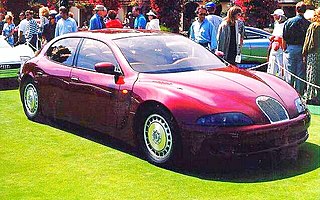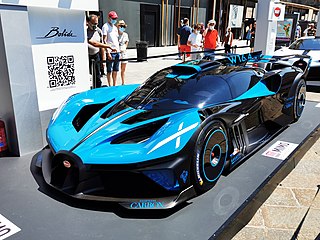
Automobiles Ettore Bugatti was a German then French manufacturer of high-performance automobiles. The company was founded in 1909 in the then-German city of Molsheim, Alsace, by the Italian-born industrial designer Ettore Bugatti. The cars were known for their design beauty and numerous race victories. Famous Bugatti automobiles include the Type 35 Grand Prix cars, the Type 41 "Royale", the Type 57 "Atlantic" and the Type 55 sports car.

The Lamborghini Countach is a rear mid-engine, rear-wheel-drive sports car produced by the Italian automobile manufacturer Lamborghini from 1974 until 1990. It is one of the many exotic designs developed by Italian design house Bertone, which pioneered and popularized the sharply angled "Italian Wedge" shape.

The Ferrari 456 and 456M are front-engine grand tourers which were produced by Ferrari from 1992 to 2003. The 456 was a replacement for the front-engine 412 as the company's V12-powered four seater. The updated 456M, which was the last Ferrari model to use pop-up headlamps, was replaced in 2004 by the 612 Scaglietti.

The Bugatti Veyron EB 16.4 is a mid-engine sports car, designed and developed in Germany by the Volkswagen Group and Bugatti and manufactured in Molsheim, France, by French automobile manufacturer Bugatti. It was named after the racing driver Pierre Veyron.

The early Bugatti 8-cylinder line began with the 1922 Type 30. The same basic design was used for the 1926 Type 38 as well as the Type 40, Type 43, Type 44, and Type 49.
B Engineering is a small-volume automobile manufacturer located in Italy. It is made up of several former employees of the Bugatti firm when it was under the leadership of Romano Artioli.
The B Engineering Edonis is a sports car developed in the year 2000 and manufactured by Italian automobile manufacturer B Engineering with overall engineering by Nicola Materazzi and styling by Marc Deschamps.

Bugatti Automobiles S.A.S. is a French luxury sports car manufacturer. The company was founded in 1998 as a subsidiary of the Volkswagen Group and is based in Molsheim, Alsace, France. The original Bugatti automobile brand was established by Ettore Bugatti (1881–1947) in 1909 at Molsheim and built sports, racing and luxury cars.

The 1994 24 Hours of Le Mans was the 62nd Grand Prix of Endurance, and took place on 18 and 19 June 1994.

The Dauer 962 Le Mans is a sports car based on the Porsche 962 Group C racing car. Built by German Jochen Dauer's Dauer Racing, a racing version of this car went on to win the 1994 24 Hours of Le Mans with the support of Porsche in LMGT1 group.

The Bugatti 18/3 Chiron is a 1999 concept car developed by French automobile manufacturer Bugatti Automobiles and designed by Fabrizio Giugiaro of Italdesign. Powered by a 6.3 L W18 engine, it is a 2-seater mid-engine coupé. The 18/3 Chiron was the last in a trio of Bugatti concept cars by Italdesign, after the 1998 EB 118 coupé and the 1999 EB 218 saloon.
Dauer Sportwagen GmbH was a German automotive company founded by former racing driver Jochen Dauer in Nuremberg. Initially founded as Jochen Dauer Racing in 1987, the racing team had several years of participation in the German Supercup and European Interserie championships, as well as occasional runs in the World Sports-Prototype Championship and Camel GT Championships with the Porsche 962. Following the demise of sports prototype racing in the early 1990s, Dauer Racing GmbH was created to begin limited production of road cars, including a road-legal version of the 962, known as the Dauer 962 Le Mans, which later went on to win the 1994 24 Hours of Le Mans. Once changing to Dauer Sportwagen, the company sold a continuation of the Bugatti EB110. The company went bankrupt in 2008 and parts for the EB110 were transferred to Toscana-Motors GmbH.

The 9ff GT9 is a sports car based loosely on the Porsche 911, built by German tuning company 9ff, founded by Jan Fatthauer. Based on the Porsche 911 (997) GT3; the cars are extensively rebuilt and fitted with a heavily modified 3.6-4.0 litre flat 6 engine that produces 738 to 1,120 bhp, depending on the configuration. One of the major differences from a normal 911 is the positioning of the engine; whilst every 911 throughout Porsche's history has been rear-engined, the GT9 is mid-engined for better weight distribution.

The Bugatti Chiron is a mid-engine two-seater sports car designed and developed in Germany by Bugatti Engineering GmbH and manufactured in Molsheim, France, by French automobile manufacturer Bugatti Automobiles S.A.S. The successor to the Bugatti Veyron, the Chiron was first shown at the Geneva Motor Show on 1 March 2016. The car's design was initially previewed with the Bugatti Vision Gran Turismo concept car unveiled at the 2015 Frankfurt Auto Show.

The Bugatti EB 112 is a concept 4-door fastback saloon presented by Bugatti Automobili S.p.A. in 1993. Giorgetto Giugiaro of Italdesign was responsible for designing the car. The EB 112 features a 456 PS V12 engine and permanent four-wheel drive system.

Paolo Stanzani was an Italian mechanical engineer and automotive designer.

The Bugatti Centodieci is a limited production mid-engine sports car produced by French automotive manufacturer Bugatti. The car is a homage to the Bugatti EB 110 and a celebration of the Bugatti marque's 110th birthday. It was revealed on 16 August 2019 at "The Quail – A Motorsports Gathering" in California, United States. The Centodieci is 20 kg lighter than the Bugatti Chiron, and has an 8,000 cc quad-turbocharged W16 engine, rated at 1,176 kW at 7,000 rpm. Production of the Centodieci was limited to 10 units priced at €8 million each.

Nicola Materazzi was an Italian mechanical engineer who developed several sports and racing cars, including the Ferrari 288 GTO, Ferrari F40, Bugatti EB110, and B Engineering Edonis. He was one of Italy's leading turbocharging specialists from the mid 1970s, a respected sports car and motorcycle engineer and is sometimes referred to as "Mr F40" or the "father of the F40".

The Bugatti Bolide is a track-only sportscar developed by Bugatti Engineering GmbH in Wolfsburg, Germany and manufactured in Molsheim, by French automobile manufacturer Bugatti Automobiles S.A.S., revealed online on October 28, 2020. According to Bugatti, the concept version of the Bolide is using the W16 engine with a weight-to-power-ratio of 0.91 kg/kW. Bugatti announced the Bolide would be the last car ever made with their W16 engine. The Bolide's name comes from the term le bolide, which literally means "the racing car" in French. The fundamental concept of the Bolide is based on a technical draft of Bugatti chief engineer and "Technical Guru" Frank Goetzke.

Bugatti made two V-12 internal combustion piston engines. The first was a quad-turbocharged, 3.5-liter engine, used in their EB 110 sports car, in 1991. The second was a 6.0-liter, naturally-aspirated unit, used in their full-size EB 112 luxury fastback sedan.
























